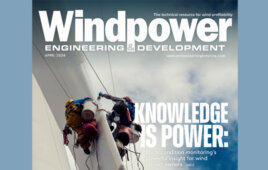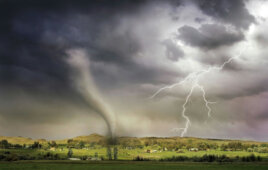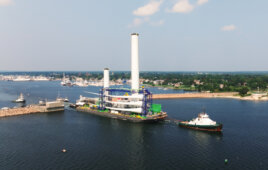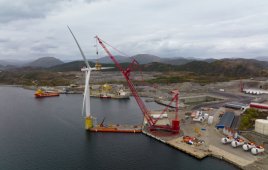The progress of industry pushes ever forward, and those technological breakthroughs are marked by named eras. Globally, manufacturers believe they’re currently experiencing the fourth industrial revolution, dubbed Industry 4.0. The wind industry is also participating, and Valery Godinez, VP of engineering and product development at MISTRAS Group, is here to discuss what that means exactly. MISTRAS is a multinational organization focused on maximizing the operational uptime and safety of critical infrastructure like wind turbines.
Below is an excerpt of the MISTRAS Group’s Wind Spotlight with Windpower Engineering & Development, but be sure to listen to the full episode here or on your favorite podcast app.
Lately people have been talking and writing a lot about concepts like Digital Transformation, Big Data, Industry 4.0, Artificial Intelligence, Smart Sensors, Digital Twins, etc. How are these themes related to each other and to the future of the wind industry?

Valery Godinez-Azcuaga
Let me take you back in time to about two and a half centuries ago, when the first industrial revolution happened, we all learn about this in school. It happened in England in the middle of the 18th century. What we’d never been taught in school is that about 100 years later, there was a second industrial revolution, and this was triggered by the availability of electric power.
Now we are in the middle of the fourth industrial revolution, in which new developments in the digital domain and the connectivity with the physical world through sensors allow us to harness the potential of digital physical interaction. And this is where all these concepts like Big Data, AI smart sensors, digital twins, are part of what is called the digital transformation, which is an intrinsic part of something that is called Industry 4.0, which is the big, big changing paradigm in this fourth industrial revolution.
There is also another concept starting to appear in conversations, Wind 4.0. What is it and what is its main goal?
It’s very interesting that this new concept of Industry 4.0 starts leaking into specific aspects in different markets. And in the case of our industry, the way people refer to the application of this new Industry 4.0 is “Wind 4.0.” And what is obvious is that Wind 4.0 includes all the aspects of wind energy generation and transmission, in all the components of a wind turbine. So, in a nutshell it’s the application of Industry 4.0 concepts to the wind industry. And what is very, very important is that Wind 4.0 has as an objective to really increase wind turbine reliability, and energy production.
How can we use data to optimize wind turbine O&M and increase uptime?
All this data will offer a continuous history of the wind turbine. If you combine it correctly, the data, for example, from inspections in the cementation of the blade, the tower, the nacelle, the drive train, bearings, the blades themselves. What you’re doing is you’re creating a digital copy of the blade, pretty much like digital copies that exist of you or me on the internet by looking at what type of movies we watch, what type of things we buy online — that’s our digital history.
Sometimes we hear the expression “data-rich but information-poor.” What does this mean, and what impact does it have in the Wind 4.0 paradigm?
When you talk to people, everybody talks about data. But you can be, drowning in data but you are starving for insights, right? All this data if it’s not correctly processed, if it doesn’t have information that can be taken to take action, it really doesn’t fulfill its purpose. You can collect a lot of data, you can sensor up a wind turbine, every single component, but unless you are able to take the data, process it and present it in a way that allows the operator or the owner of that turbine to take action, that data is useless. That is the challenge that we’re facing.
This podcast is sponsored by MISTRAS Group

Filed Under: Featured, Podcasts




